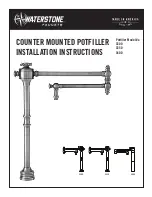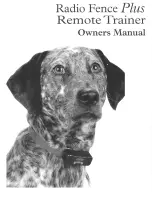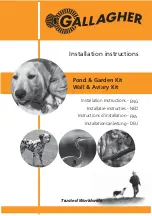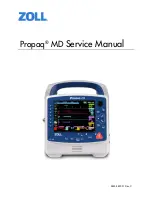
2
to do this is to take time to manipulate their paws for
a few minutes at least once daily. Giving your pet a
snack that they enjoy is a good way to associate hav-
ing their feet touched with a positive food-related
experience.
The next step is to get the pet gradually accustomed
to the rotary tool itself. Let the pet sniff the tool while
it is turned off. Next while keeping the tool in your
hand, turn the tool on and let him get used to the
sound it makes. Try to get him to sit or lay on his
side while the tool is in your hand and running.
Eventually, you need to work up to being able to
touch the rotating sanding drum to the pet’s toenails.
Do no grinding at this time; simply let the animal
become familiar with this new situation. You do not
need to touch the tool to the nail for more than a sec-
ond.
Throughout the entire acclimation process, continue
to praise the pet and reward good behavior with his
favorite snack. This process may take a couple of
days or even weeks. Before long, both you and your
pet will be able to relax and even enjoy this grooming
time that you share together.
Nail Anatomy
Before trimming pet nails you will need to be able to
identify the quick. The diagram shows the basic
anatomy of a dog’s toenail. The outer nail is hard,
and has no feeling because it has no nerve endings.
The core of the nail is the quick. It is made up of tiny
blood vessels, nerve endings and is very sensitive.
The quick is a vein that “feeds” the toenail. Should
you cut the quick while trimming a nail, the nail will
start to bleed.
Light colored nails are often transparent enough to
allow you to see the quick’s pink core. Dark colored
nails may not allow you to see where the quick is.
Sometimes, dog’s have both light and dark colored
nails that allow you to estimate the length of the
quick.
The diagram also shows the ideal angle in which to
trim a pet’s nails. The proper angle may vary accord-
ing to the pet owner’s wishes or the pet’s unique
anatomy.
The Nail Grooming Process
It is important to let the speed of the rotary tool do
the work. You should never apply pressure to the
toenail with the spinning sanding drum. Allow the
speed of the sanding drum to remove the nail
material without adding pressure. Pressure causes
the nail to get too hot causing discomfort for your
pet.
The rotary tool’s spinning sanding drum should not
be kept against the nail longer than three seconds
at a time. It is recommended that you alternate
between all the nails on two paws at a time. This
rotation method allows the nails to cool before they
are ground a second time.
Support the toe and nail in one hand while using
the rotary tool in the other hand. This lessens the
vibration of the grinding procedure and is more
comfortable for your pet. Pushing gently on the
bottom of the paw’s pad extends the nail slightly
for easier grooming.
Pet Safety
Secure the pet. Some pets may become nervous in
the presence of the tool. The operator needs both
hands to groom the nail. It may be helpful to have
another person assist in restraining the pet.
Keep pet hair away from spinning parts. Hair can
entangle in the tool, causing injury to your pet.
Safety Tips
Should hair be accidentally caught in the rotary tool,
immediately turn off the tool and untangle the hair
from the tool.
ANGLE
OF CUT
FLOOR
DOG’S PAW
QUICK
1600A016V2.qxp_7300PT 1/15/18 9:28 AM Page 2






























